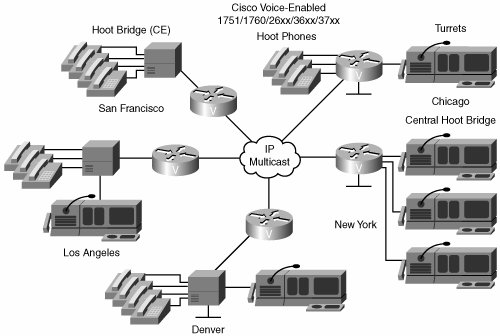Hoot and Holler
| A hoot and holler network, as illustrated in Figure B-1 (also known as a junkyard circuit, squawk box system, holler down circuit, or shout down circuit), provides always-on multiuser conferences without requiring users to dial in to a conference bridge. This type of network was devised more than 50 years ago when local concentrations of small, specialized businesses needed to communicate common, time-critical information. Junkyard operators up and down the East Coast of the United States were among the first users of these networks. They began to install their own telephone wires, speakers (called squawk boxes), and microphones to share information with other locations about parts that their customers needed. These networks functioned as crude, do-it-yourself, business-to-business intercom systems. Figure B-1. Hoot and Holler Hoot and holler broadcast audio network systems have evolved into the specialized leased-line networks of today. Financial and brokerage firms use these networks to trade stocks and currency futures and provide time-critical information, such as market updates and morning reports. In addition to financial and brokerage firms, users of various forms of hoot and holler networks include news agencies, publishers, government and municipal emergency response agencies, weather bureaus, transportation providers, utility operators, manufacturers, collectibles dealers, talent agencies, airlines, and nationwide salvage yard organizations. Hoot and holler over IP transports hoot and holler voice traffic over traditional data networking equipment on an existing enterprise multiservice network. Hoot and holler enables businesses to eliminate expensive, dedicated leased lines while protecting investments in existing hoot and holler equipment such as turrets, bridges, and four-wire telephones. In addition to eliminating leased lines, running hoot and holler traffic over an IP network allows businesses to utilize bandwidth more efficiently. When bandwidth is not being used for hoot and holler traffic, it can be made available for data. Hoot and holler requires that IP multicast be active on the routers that support the hoot and holler circuit. The connections are configured using special dial peers configured with session protocol multicast. |
EAN: 2147483647
Pages: 111